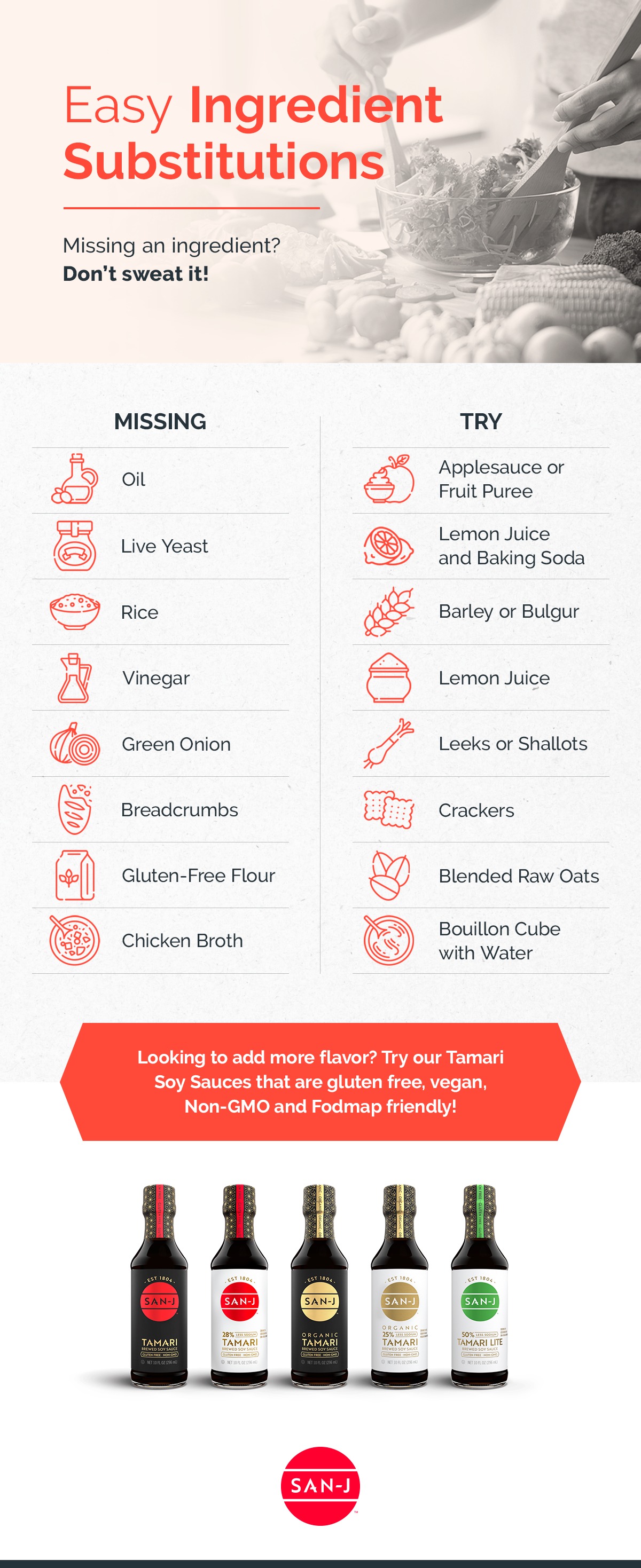Have you ever tried to follow a recipe that asked for an ingredient you didn’t have? Fortunately, there are many ways to substitute your missing ingredient with something you have on hand. Here are some of the most common alternative ingredients, plus some vegan alternatives.

Common Ingredient Substitutions
Some cooking alternatives are obvious. Others are far more unconventional and have varying degrees of success. When cooking different cuisines you may run into a situation where a substitution is needed if you do not have that item in your home. Here are several of the most useful substitutions we’ve seen:
- No oil? Try applesauce or another fruit puree instead.
- Combine lemon juice and baking soda to replace live yeast.
- If you run out of rice, use barley or bulgur.
- Use a bouillon cube with water for chicken broth.
- Need gluten-free flour? Try blending raw rolled oats.
- Use lemon juice in place of vinegar.
- Out of tomato sauce? Mix tomato paste with water.
- Try leeks or shallots instead of green onion.
- Blend sugar and molasses for brown sugar.
- Try using yogurt instead of mayo and sour cream.
- No baking powder? Mix baking soda and cream of tartar.
- Mix milk with lemon juice or white vinegar in place of buttermilk.
- If you’re all out of half-and-half, try whole milk and melted butter.
- Try mixing butter with unsweetened cocoa powder for unsweetened chocolate.
- Crush crackers and use them instead of breadcrumbs.
- For corn syrup, combine sugar and water.
Vegan-Specific Substitutions
Avoiding ingredients derived from animals can put constraints on your diet. Luckily, inventive vegan alternatives exist to make more foods plant-based. Vegan replacements like egg substitutes, vegan cheeses and other manufactured products exist, but let’s talk about the ingredients you have in your home that can act as a substitute for animal-based products. Some of them include:
- Mix ground flax seeds and water for an eggless emulsifier.
- Mashed banana and pureed tofu can replace eggs, too.
- Consider opting for plant-based milk like soy or oat milk.
- Vegetable shortening has the same emulsifying properties as butter.
- Instead of honey, try agave nectar or cane sugar.
- Use cream from full-fat coconut milk with sea salt and lemon juice or vinegar for sour cream.
Is Soy Sauce Vegan?
Yes, typically soy sauce is vegan but it is always a good idea to read the ingredients on the label. At SAN-J, we brew our Tamari Soy Sauce with all soybeans and no wheat. Soy sauces are typically vegan but some soy sauces pose other concerns for consumers:
- Gluten: Most brands make soy sauce from soybeans and 40% to 60% wheat, which means it is not safe for people with gluten intolerances. We make SAN-J Tamari Soy Sauce with 100% soybeans and no wheat, and it is certified gluten free.
- Sodium: We have several low-sodium sauces that retain our authentic taste and cater to those who must take in less sodium.
- Additives: We use a brewing method passed down over eight generations to make our Tamari. We never add artificial preservatives, flavors, or colors. SAN-J has organic soy sauces, including an organic reduced-sodium option.
We’re committed to brewing genuine Tamari Soy Sauces that can meet your dietary needs. Find your favorite today!
Back to Top

